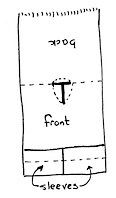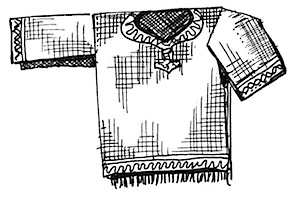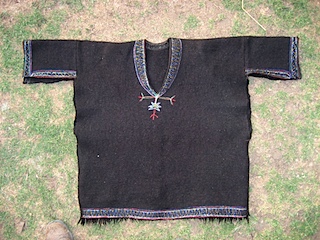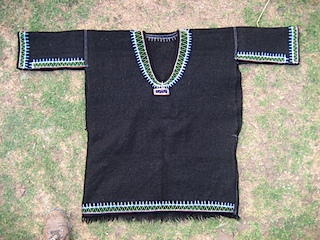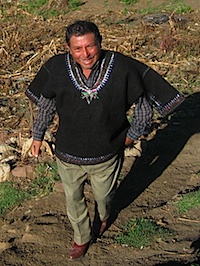 I occasionally mention the capishay, our local traditional garb for Q’anjob’al men. It’s something that greatly interests me, so I’d like to take a few minutes to talk about it.
I occasionally mention the capishay, our local traditional garb for Q’anjob’al men. It’s something that greatly interests me, so I’d like to take a few minutes to talk about it.
A capishay is a heavy, poncho-shaped tunic. They’re made from the wool of the black sheep that dot the grassy hillsides and valleys in this part of Huehuetenango. The undyed wool is full of lanolin, making the capishay highly water repellant– a great thing here, where it is rainy, misty, or foggy eight days out of ten.
The woolen fabric of the capishay is woven from twisted strands of wool that are then felted, making it really tough and dense. Because of the weave, three sides of the fabric are selvage and the bottom has a natural fringe of twisted yarns. To make the capishay, the fabric is cut apart where shown with the solid lines, then folded along the dashed lines. The sleeves are sewn to the body at the shoulder, the sides are sewn halfway up, and the outer half of the bottom of the sleeves are sewn together (1). The embroidery serves a double-duty as stitching to hold down the hems on any cut edges. In all, a very clever design with no wastage.
Wait- the sides are open? Yeah. To wear it, you stick your arms through the “armpit vents”; the sleeves are narrow enough that they are not much more than decoration, and they flap in the wind like little wings. Check out Nas Palas in the picture above to see what I mean. This garment is so functional, and this final step so impractical, the only thing I can figure is that many generations ago someone tried it as a fad/party stunt. It caught on, and eventually the people forgot that it had ever been any other way.
A few months after we arrived in our village, I decided I had to have one. Besides wanting to show support for local tradition, I was slowly freezing to death. The idea of wearing a thick waterproof blanket everywhere I went was very appealing. So, I asked around. Where do you get one? How much should one cost?
The locals told me that the tradition of making them is dying out, but there is still one guy left that does it, and he lives in Soloma. A fair price, they said, is about 500q. After a discussion with Emily, we decided that I could spend a week’s pay to be warmer and show support for the local culture. We made the hourlong journey to Soloma, and after asking around in the open-air market, we eventually found the table of the capishay vendor. He had three for sale, and one fit (sortof). He asked the 500q we were expecting, so I paid him and was on my way, a proud new capishay owner.
The next day was pretty cold, so I donned my new Mayan gear and went into the village. “Ho, Solomero!” somene yelled.
“Why Solomero?” I asked. “You know I live in that green house right over there.”
“Your capishay!” he smiled. “It’s in the style of Soloma.”
Um, what? A further discussion revealed that there are actually subtle differences between capishays, things that are invisible to the unintiated. The Soloma capishay (left photo) has metallic reflective embroidering and the pattern of the embroidery trim is relatively straight. The decoration at the base of the neck is often the “chicken feet” design. The Santa Eulalia capishay, however, has nonmetallic embroidery with little spikes surmounting the straight edging (right photo). The design at the base of the neck is usually a flower (more on that later). If you go even farther north to San Mateo Ixtatan, the capishay‘s sleeves aren’t sewn closed and have rounded corners. But even better than that, they have a kangaroo pocket in the front. How’s that for practical?
“How much did you pay for it?” the guy continued. People around here ask that about everything. At first we found it rude, but we soon realized that in a culture where nothing has a price on it and everything is haggled for, having up-to-date market information is a necessity for everyone.
“500 quetzales,” I shrugged.
He let out a whistle. “Too much, hombre. You can get them here in Santa for 350.”
And that, you see, is how things are here. Plenty of information can be had, but usually after the fact when it does you no good. I asked around some more, and it turns out the two people we’d spoken to beforehand were the only two that didn’t know 350q capishays can be had in the nearest town, in the style everyone (except me) wears. Sigh.
Now, that doesn’t mean that people don’t love my capishay. I get excited comments all the time from people who can’t believe a gringo would wear one, and are tickled to see me supporting (validating?) their culture. But the truth is, I have always been a little dissatisfied with my capishay. I’m average size for a white guy (6′-0″) but GIANT for a Mayan, so it’s a little short on me. Also, I want to show support for the home team, not Soloma.
So, after nearly a year of searching, asking around, missed meetings, and getting lost in the back alleys of Santa Eulaia, I finally hooked up with Rafael, one of the last remaining capishay makers in our region. He is a very friendly guy, and was excited to meet me… and even MORE excited to make me a custom capishay to my own specifications. Embroidery in the local style, no metallic thread. I also had him do a special design in the neck: rather than a flower, I wanted a Thor’s Hammer (2). And the size was to be extra-long, to accommodate all that gringo height. “It will cost you a little extra,” Rafael said. “You’re so tall, I will have to cut into a second piece of cloth to make the sleeves.”
“How much?” I asked, hoping my hour of small talk beforehand had positively influenced our transaction(3).
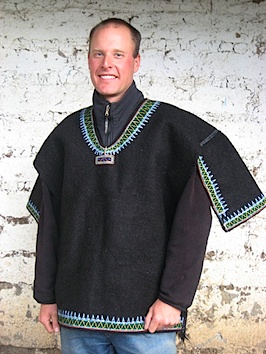 He pondered a minute, then threw out 400q as a first offer. I didn’t even haggle, I was so excited to finally have my dream capishay (4). And here it is, in all its glory.
He pondered a minute, then threw out 400q as a first offer. I didn’t even haggle, I was so excited to finally have my dream capishay (4). And here it is, in all its glory.
Now only one thing remains, my last capishay quest. Turns out, Rafael only actually assembles them. He gets his fabric blanks from someone else, and they are getting harder and harder to come by. The process of turning the wool into that crazy, thick, woven-then-felted fabric is interesting to me, and I have to see how it’s done, firsthand. But almost no one is left that still does it.
“Where do you get your material?” I asked him.
“It’s tough. There is a guy named Miguel Felipe in Pett that sometimes makes it, he lives up above the school.” That’s within walking distance of my village, so I took the name down, and made a note to go look for the guy next week.
“Anyone else?” I asked.
He pondered a bit, chin in hand, then his eyes lit up. “Oh, and there’s a guy in Soloma, too.”
1) I had some help figuring this out from expert weaver Judy Middleton. She saw my capishay when I was home for Christmas break, and promptly reverse engineered it. It wouldn’t surprise me if she’d recreated her own by the time I get back.
2) Eat your heart out, Belkar.
3) I think I rolled in the high teens on my Charisma check.
4) I then subsequently rolled a 2 on my Barter skill check.
